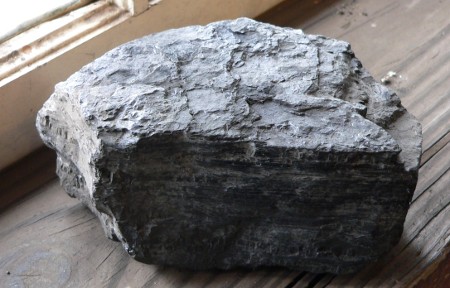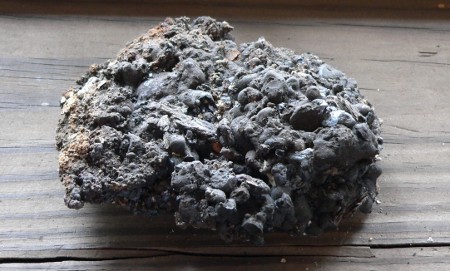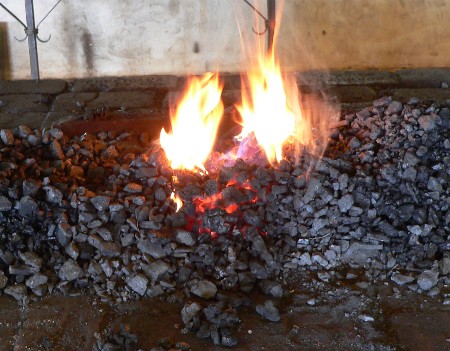
Introduction
There are a number of fuels you can use to heat iron for blacksmithing. For most of our work at Heritage Forge, we use coal. Coal is available in several grades, including lignite, bituminous and anthracite. In this article, I discuss the ranking of coal, the type of coal best-suited for blacksmithing and several important points related to the use of coal in your forge.
Grades of Coal
Coal consists primarily of carbon and secondarily of hydrogen, sulfur, oxygen and nitrogen, along with other metallic and non-metallic elements and minerals. Coal is classified both by rank and grade. There is a lot that could be said about rank and grades of coal, but I will stick to what is most relevant to blacksmiths. Coal’s rank is determined by the amount of water, volatile matter and elemental carbon in the coal, as well as its heat content, also known as its calorific value (measured in BTUs). A higher rank coal contains less moisture and volatile matter than a lower rank and has a higher heat content. Grade has to do with coal’s economic value and depends on the amount of minerals, or impurities, contained in it. The composition of coal depends on the conditions in which it was formed, and in some cases, a low-rank coal may be of a higher grade than a high-rank coal. Though additional ranks of coal exist, as blacksmiths, we are concerned mainly with these three: lignite, bituminous and anthracite.
Lignite Coal
Also known as brown coal, lignite is the softest and lowest rank of coal. It is not far removed from peat in its composition and appearance, and it has a distinctly woody texture. Lignite is generally either strip-mined or mined in open pits. Most Texas coal is low-grade lignite, used mainly to power electric plants. As a rule, lignite contains the highest proportion of nonburnable minerals and sulfur of any rank of coal.

When you burn any type of coal, the nonburnable minerals in the coal, such as metals and silicas, will melt and coagulate in the bottom of the firepot, forming a sticky semi-solid mass known as “clinker”. As clinker builds up, it will begin to block the forge’s air flow and draw heat away from the fire. In fact, that is why old-timers called clinker a “thief”. Because clinker emits contaminants in a hot fire, its presence, even in small amounts, will inhibit forge welding. Although lignite can be used in a forge, it will produce more clinker than any other grade of coal, making it poorly-suited for blacksmithing.
Bituminous Coal
Bituminous is the coal-of-choice for the blacksmith. It is a soft, mid-grade, black coal. Mined from deeper mines than lignite, it burns much more cleanly. When burning coal in the forge, we keep a “stock pile” of wet coal on the sides of the fire. As it smolders, most of the impurities are burned away, leaving primarily carbon, in the form of what we call coke.

Having been reduced, coke burns very cleanly and hot, and it is what we heat the steel with. When you properly build and maintain a fire in the forge using bituminous coal, it will produce coke that sticks together in large chunks. The heart of the fire emits a very intense light that can be harmful to your eyes, but by maintaining the fire properly, the smith can keep the heart of the fire covered by a dark layer of coke to shield his eyes from the intense light.
Bituminous has a low sulfur content, which is important for several reasons. Sulfur lowers the quality of the coke, contaminating the steel you are working and causing it to become brittle. It also pollutes the air with sulfur dioxide and sulfur trioxide. When combined with oxygen and water, it forms sulfuric acid, which is very corrosive to all the metal parts of the forge and chimney.

Anthracite Coal
Anthracite is the hardest and highest rank of coal available. It is considered a metamorphic rock. When split, it has a bright, shiny cleavage. Anthracite is generally the cleanest burning coal, and it contains the most energy (BTUs) per pound. However, unlike bituminous, the pieces of coke that anthracite produces are small and tend to blow up and out of the fire. Because of this, it also does not shield the smith from the brightness of the heart of the fire and is not as commonly used for blacksmithing.
In the U.S., anthracite is mined from deep mines in small areas of Pennsylvania and Oregon. An interesting historical fact is that during the American Civil War, blockade runners used anthracite to fuel their steam boilers. Any smoke would give them away, but anthracite was so clean-burning that it produced no visible smoke.
Conclusion
In conclusion, bituminous is the best coal for the blacksmith. It is relatively clean-burning, cokes up nicely, making it easy to manage the fire well, and it produces relatively little clinker. Some of the best bituminous coal in the south is taken from mines near Birmingham, Alabama, which are the source of the coal we use at Heritage Forge.
